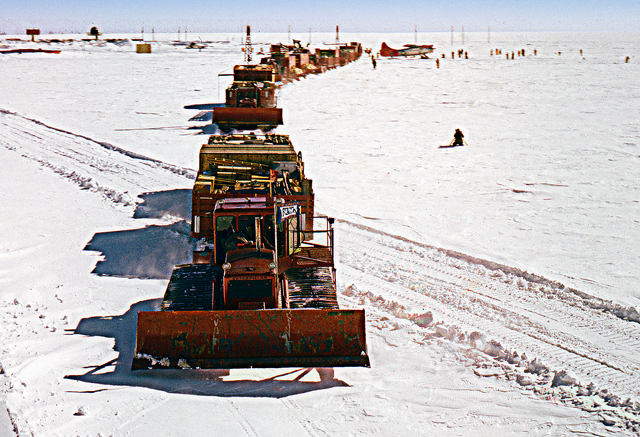Page 2/2 - Posted June 12, 2009
MovesDuring the 1981-82 summer season, a crew built a new modular, sled-mounted camp to get away from the Korean War-era Jamesways, or tent-like buildings. The six-unit, interconnected camp included a self-contained water production unit. The camp design allowed a crew to quickly disconnect it and store it on snow berms at the end of each season to offset the effects of drifting snow accumulation. “This incarnation of the camp is a significant improvement over the Jamesway camp used in past seasons,” according to an NSF memo dated May 7, 1990. The camp continued to move around through the 1980s. Crews pushed it near the skiway, or landing strip, in 1983 — a job that took a little more than 24 hours beginning on Dec. 1. Byrd slightly shifted locations again in 1986, though the new site offered an uneven surface. Snapshot in time: Byrd in 1970-71
♦Latitude: 80°S
♦Longitude: 119°W
♦Elevation: 1,553 meters (5,095 feet)
♦Annual mean temperature: -28.2C (-18.8F)
♦Lowest recorded temperature: -63.2 (-81.8F) in July 1958
♦Highest recorded temperature: -0.8C (31F) in January 1961
♦Maximum gust: 76 knots in June 1965
♦Air distance from McMurdo: 1,400 kilometers (885 miles)
♦Air distance from South Pole: 1,100 kilometers (675 miles)
Differential settling of the sled-mounted berthing module, caused by heat radiating from the galley (and probably the proximity of the camp’s wastewater outfall to the sleds), had caused minor structural damage to the galley and bathroom unit. By the 1988-89 season, however, differential settling was causing a host of problems — doors didn’t fit correctly in frames and floors buckled between the units. The camp began the 1990s with yet another move to stave off further damage. By that time, Byrd mostly functioned as an emergency diversion landing and support station for intra-continental flights, and as a weather observation site. An end and a new beginningByrd Surface Camp continued its deep-field work into the 21st century. It served as the starting point of the U.S. International Trans-Antarctic Scientific Expedition (ITASE) Apparently destined to be swept into the dustbin of history, with work already under way to remove the remnants of the last structures and equipment, Byrd Surface Camp is scheduled to return this coming season with a new mission and a population of up to 50 people. “That’s the nature of our business. Things change all the time,” noted Chad Naughton, a science planner for the USAP who helped plan the latest incarnation of Byrd. Sources: Deep Freeze: The United States, the International Geophysical Year, and the Origins of Antarctica’s Age of Science by Dian Olson Belanger (University Press of Colorado, 2006) |



For USAP Participants |
For The Public |
For Researchers and EducatorsContact UsNational Science FoundationOffice of Polar Programs Geosciences Directorate 2415 Eisenhower Avenue, Suite W7100 Alexandria, VA 22314 Sign up for the NSF Office of Polar Programs newsletter and events. Feedback Form |


